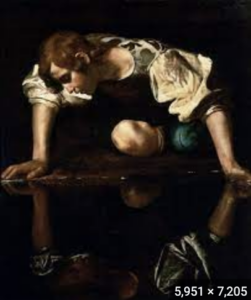In the fourth poem in Christina Rosetti’s “Monna Inominata” sequence, the speaker’s paced, contemplative structure combats the hypermasculine carpe diem tradition. The speaker untangles the “us” so favored by Andrew Marvell in his poem, “To His Coy Mistress” to engage in a genuine discussion of identity and mutual love.
The first four lines of the poem are a direct address to the carpe diem poets of the past: “I loved you first: but afterwards your love / Outsoaring mine, sang such a loftier song / As drowned the friendly cooings of my dove. / Which owes the other more?” (l. 1-4). The speaker professes how her love is quiet and her concern that the poet loves her too loudly, too performatively in regimented, iambic pentameter lines. The bird imagery of these lines both recalls Marvell’s poetry, in which he describes “devouring…birds of prey”: a violent, rushing image meant to supplement his argument for casual sex because he claims that time is running out in a woman’s sexual prime. The speaker takes issue with the idea that this “love” is lauded over a more tender connection, emphasized in the figure of the dove and the gentle phonemes of the word “cooing.” To further combat this insistence on fast paced love, the speaker interrupts the fourth line with a rhetorical question which is visually shocking and forces the reader to contemplate the implications of a casual sexual relationship, particularly for a woman.
The speaker continues, “My love was long / And yours one moment seemed to wax more strong; / …you construed me” (l. 4-6). The speaker emphasizes the fluctuations of the male persona’s actions of love, contrasting them with her own using a distinctly Renaissance masculine euphemism, “long.” Whereas a male speaker may use this slight of hand to refer to an erection, the female speaker uses it to testify to the security of an emotionally invested relationship. The long-ness further engages the desires of Marvell’s male speaker, who wishes to “make [our] sun run” since they cannot “make [him] stand still.” Rosetti’s speaker is concerned with the way that the lover’s affections “wax” in accordance with her willingness to engage with him sexually, the same preoccupations of Marvell’s speaker. Neither man is patient. They wish instead to make of the lover what they wish to achieve this end, emphasized by the enjambed lines.
However, the final couplet struggles with the format: “Both have the strength and both the length thereof, / Both of us, of the love which makes us one” (l. 13-14). Scanning these lines indicates a break in the highly structured format of the poem, particularly in the final line. The first line emphasizes how both partners must commit to the stability and endurance of their love. But to reinforce this claim, there is a spondaic substitution at “makes us” which replaces the iambic foot. Until this moment, the speaker has been restricted to formal iambic pentameter, and perhaps this moment is an extension of the volta break where the speaker finds a way to actually say what she needs to. Emphasizing “makes us” in the line conveys a set of requirements that must be met before the partners become one, likely the mutual, reliable expressions of love. Leaving “one” unaccented in this line negates the compulsory short-term “coupling” that Marvell suggests in his couplet forms.
In the final lines, the formal structure struggles to contain the speaker’s sentiments. Rosetti writes a skillful sonnet response which challenges Petrarchan silencing of female subjects and Marvell’s participation in a sexually charged tradition at once.
Marvell, Andrew. “To His Coy Mistress.” Poetry Foundation, https://www.poetryfoundation.org/poems/44688/to-his-coy-mistress. Accessed 14 April, 2023.


